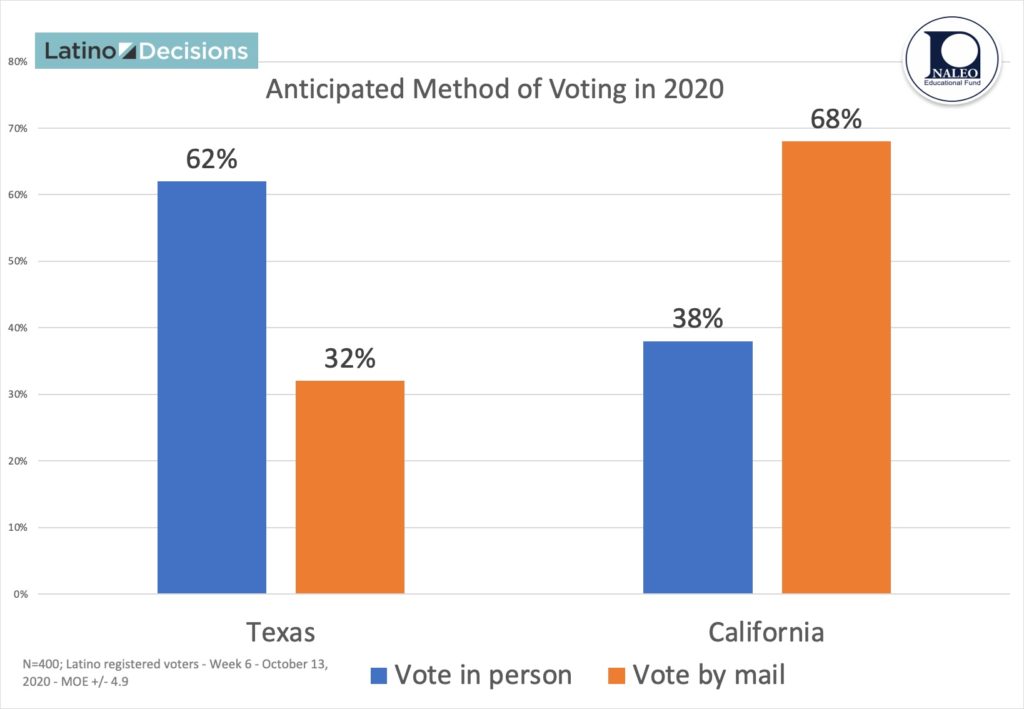On September 8, 2020 Latino Decisions and the National Association of Latino Elected Officials Education Fund launched the 2020 nine-week tracking poll of the Latino electorate. Every week leading up to the presidential election we will survey 400 registered Latinos, gaining crucial insight on the nation’s largest group of non-white eligible voters.
Texas is experiencing a seismic demographic and political shift because of the growth of the Hispanic population. Latino Decisions has noted that close to 400,000 Latinos in the Lone Star State turned 18 in just two years (2018 and 2020). In a close presidential race, this group of young Latinos could be decisive in allocating the state’s 38 electoral votes. With Trump’s current lead standing within the margin-of-error and elections polls being notorious for undercounting Latino voters, there are positive signs that Texas could go blue in 2020. Can Democrats and Hispanics turn Texas blue in 2020?
Political comparisons are often made between Texas and California, since both have sizable Mexican American populations and a total Hispanic population of 39 percent in each state. Despite these demographic similarities, California is often held as a model for Democratic and Latino political empowerment since the state is solidly blue. The fact that Texas has yet to turn blue is often attributed to cultural differences between Californios and Tejanos. Tejanos are seen as more religious and politically conservative than their Californio brothers and sisters. At times it is suggested that left-coast Californios are more politically radical and engaged. Yet, if we move beyond anecdotes and stereotypes, we find that the biggest impediment for Tejano political empowerment is not cultural, but structural.
The data from our combined tracking poll (week 1 through week 5) show that Tejanos are as politically engaged as Californios. Although a slightly larger number of Californios say they are certain to vote, these differences are within the margin of error and statistically insignificant. Moreover, if we sum the respondents who report they are certain to vote with those who say they will probably vote, the numbers are identical, or 91 percent. In questions that ask about the degree to which they are following the election or levels enthusiasm, the results are nearly identical. Californios and Tejanos are equally engaged in the 2020 election.
Turning to the issue of vote choice and the belief that Tejanos are more politically conservative, we find that Californios are more likely to vote for Biden (71%) than Tejanos (66%). Yet, this difference is again within the margin of error. Indeed, Trump has the same level of support in both states, 20 percent. Biden’s lesser support among Tejanos is due to the fact that more of them remain undecided. When asked to evaluate the political parties, Californio and Tejano responses are nearly identical. Clearly, the belief that Tejanos are more conservative or less inclined to support the Democratic Party and its candidates is not supported by our data. Nonetheless, the fact remains that California is a deep blue state while Texas has yet to turn blue.
So, why are Tejanos struggling to turn Texas blue? Unlike Californios, Tejanos face a number of barriers that limit their access to the ballot box. In this presidential election, California mail-in ballots are automatically sent to voters. In Texas, you must be over 65 years of age or provide a reason for voting by mail beyond concerns over COVID. In addition, Texas Governor Greg Abbott has sought to limit the number of mail ballot drop off locations. LULAC, the nation’s oldest Latino civil rights organization is challenging these barriers, yet the legal outcome and process won’t be settled for some time. In our survey, 44 percent of Tejanos said they were unfamiliar with the vote by mail process, while just 22 percent of Californios said they were not familiar with the process – a sizable gap in education about the state’s electoral process that could be overcome with a strong investment.
Tejanos and Californios were also asked if they plan to vote in-person or by mail. Significant differences emerge, with the majority of Tejanos planning to vote in-person, while a majority of Californios are voting by mail. Keeping in mind that we are in the midst of a pandemic that is disproportionately impacting Latinos; the desire to protect oneself and family members from this deadly virus may end up discouraging Tejanos from going to the polls. Even if Tejanos vote in person, there may be additional obstacles that invalidate their ballots. The recent gutting of key provisions of the Voting Rights Act by the Supreme Court is a serious challenge to Latino political empowerment broadly.
Tejanos will turn Texas blue, if given a chance. Contrary to stereotypes, Tejanos are not politically disengaged or conservative. Tejanos have a long and deep history of progressivism and political participation, beginning with the creation of LULAC in 1929 and later the Viva Kennedy Clubs in 1960. That same energy may give Biden a winning edge. Biden is making a move to win the Latino vote in Texas and, with that, the whole enchilada. In our survey Tejanos are reporting higher rates of get-out-the-vote contact than Californios, and in our latest poll, the number of Latinos being contact by Democrats is significantly higher than in 2016. It would be naive to suggest that Tejanos are not facing an uphill battle in turning the state blue. Yet, Tejanos have defied the odds before. In 1960 the Viva Kennedy generation had an audacious plan to deliver Texas to Irish-Catholic John F. Kennedy; they succeeded. It’s possible that in 2020 this generation will deliver the state to another Irish-Catholic, Joe Biden.
Adrian D. Pantoja is associate dean of faculty and professor of politics at Pitzer College, and Senior Analyst with Latino Decisions.




